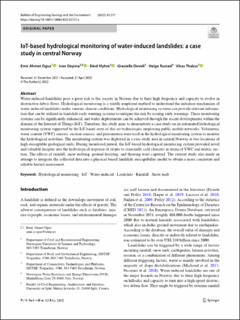| dc.contributor.author | Oguz, Emir Ahmet | |
| dc.contributor.author | Depina, Ivan | |
| dc.contributor.author | Myhre, Bård | |
| dc.contributor.author | Devoli, Graziella | |
| dc.contributor.author | Rustad, Helge | |
| dc.contributor.author | Thakur, Vikas Kumar Singh | |
| dc.date.accessioned | 2022-05-24T11:00:39Z | |
| dc.date.available | 2022-05-24T11:00:39Z | |
| dc.date.created | 2022-05-21T11:40:07Z | |
| dc.date.issued | 2022 | |
| dc.identifier.issn | 1435-9529 | |
| dc.identifier.uri | https://hdl.handle.net/11250/2995850 | |
| dc.description.abstract | Water-induced landslides pose a great risk to the society in Norway due to their high frequency and capacity to evolve in destructive debris flows. Hydrological monitoring is a widely employed method to understand the initiation mechanism of water-induced landslides under various climate conditions. Hydrological monitoring systems can provide relevant information that can be utilized in landslide early warning systems to mitigate the risk by issuing early warnings. These monitoring systems can be significantly enhanced, and wider deployments can be achieved through the recent developments within the domain of the Internet of Things (IoT). Therefore, this study aims to demonstrate a case study on an automated hydrological monitoring system supported by the IoT-based state-of-the-art technologies employing public mobile networks. Volumetric water content (VWC) sensors, suction sensors, and piezometers were used in the hydrological monitoring system to monitor the hydrological activities. The monitoring system was deployed in a case study area in central Norway at two locations of high susceptible geological units. During monitored period, the IoT-based hydrological monitoring system provided novel and valuable insights into the hydrological response of slopes to seasonally cold climates in terms of VWC and matric suction. The effects of rainfall, snow melting, ground freezing, and thawing were captured. The current study also made an attempt to integrate the collected data into a physical-based landslide susceptibility model to obtain a more consistent and reliable hazard assessment. | en_US |
| dc.language.iso | eng | en_US |
| dc.publisher | SpringerLink | en_US |
| dc.rights.uri | http://creativecommons.org/licenses/by/4.0/deed.no | |
| dc.subject | Hydrological monitoring | en_US |
| dc.subject | IoT | en_US |
| dc.subject | Water-induced | en_US |
| dc.subject | Landslide | en_US |
| dc.subject | Rainfall | en_US |
| dc.subject | Snow melt | en_US |
| dc.title | IoT‑based hydrological monitoring of water‑induced landslides: a case study in central Norway | en_US |
| dc.type | Peer reviewed | en_US |
| dc.type | Journal article | en_US |
| dc.description.version | publishedVersion | en_US |
| dc.rights.holder | © 2022 The authors | en_US |
| dc.subject.nsi | VDP::Teknologi: 500 | en_US |
| dc.source.volume | 81 | en_US |
| dc.source.journal | Bulletin of Engineering Geology and the Environment | en_US |
| dc.identifier.doi | 10.1007/s10064-022-02721-z | |
| dc.identifier.cristin | 2026154 | |
| dc.relation.project | Norges forskningsråd: 281059 | en_US |
| dc.rights.license | CC BY 4.0 | |
| dc.source.articlenumber | 217 | en_US |
| cristin.ispublished | true | |
| cristin.fulltext | original | |
| cristin.qualitycode | 1 | |

